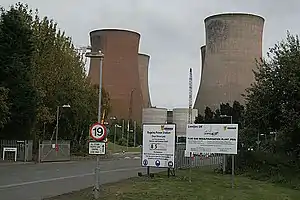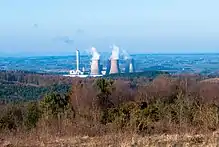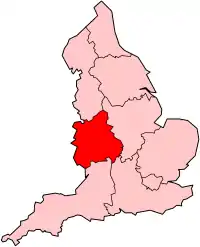Rugeley power stations
The Rugeley power stations were a series of two coal-fired power stations located on the River Trent at Rugeley in Staffordshire. The first power station on the site, Rugeley A power station was opened in 1961, but has since been closed and demolished. Rugeley B power station was commissioned in 1970, and closed on 8 June 2016.[1] The cooling towers of which were demolished on 6 June 2021. It had an output of 1,000 megawatts (MW) and had a 400 kilovolt (kV) connection to the national grid. The B station provided enough electricity to power roughly half a million homes.[2]
Rugeley A (1961–1995)
| Rugeley power station A | |
|---|---|
| Country | England |
| Location | Rugeley |
| Status | Closed |
| Construction began | 1956 |
| Commission date | 1961[3] |
| Decommission date | 1995[4] |
| Operator(s) |
|
| Thermal power station | |
| Primary fuel | Coal |
| Power generation | |
| Nameplate capacity | 600 MW |
| External links | |
| Commons | Related media on Commons |
History
Construction of the A station started in 1956.[4] The station's generating sets were commissioned between 1961 and 1962.[5] The station was the first joint venture between the Central Electricity Generating Board (CEGB) and the National Coal Board (NCB). The station took coal directly from the neighbouring Lea Hall Colliery by conveyor belt.[4] This was the first such arrangement in Britain. The colliery was put into production some 6 months before the first generating unit was commissioned in the power station. The station was officially opened on 1 October 1963 by Lord Robens of Woldingham and Sir Christopher Hinton.
The first of the five cooling towers to be completed at Rugeley in 1960 was the world's first large dry cooling tower and the first large scale experiment with a design aimed at eliminating water loss.[4] The dry tower was commissioned in 1962 but its capital and operating costs were considerably higher than a conventional wet tower. No further dry towers were constructed in the UK.[6] On occasions this tower was used by the RAF for parachute development. Rugeley A was also the first power station in Britain to be controlled entirely from a central control room.[4] The total cost of building it was £30 million.
Design and specification
The station had five 120 MW generating sets which gave it a generating capacity of 600 megawatts (MW). The boilers operated on pulverised coal and delivered 540 kg/s of steam at 103.4 bar and 538 °C.[7] Rugeley A was one of the CEGB's twenty steam power stations with the highest thermal efficiency; in 1963–4 the thermal efficiency was 33.34 per cent, 31.75 per cent in 1964–5, and 31.42 per cent in 1965–6.[8] In 1980–1 the station sent out 2,612.838 GWh, the thermal efficiency was 29.56 per cent.[7] The annual electricity output of Rugeley A was:[7][9]
| Year | 1960–1 | 1961–2 | 1962–3 | 1963–4 | 1964–5 | 1965–6 | 1966–7 | 1971–2 | 1978–9 | 1980–1 | 1981–2 |
|---|---|---|---|---|---|---|---|---|---|---|---|
| Electricity supplied, GWh | 119.2 | 1,379.2 | 2,873.1 | 3,361 | 3,058 | 2,953 | 3,309 | 2,544 | 2,633.9 | 2,612.8 | 2,433 |
| Thermal efficiency, % | 31.12 | 32.81 | 33.01 | 33.34 | 31.75 | 31.42 | 31.75 | 30.54 | 30.08 | 29.56 | 30.94 |
Closure
The closure of the A station began in 1994. Two of the station's generating units were decommissioned, with the other three following in 1995.[5] Having burned nearly 42 million tonnes of coal in its lifetime,[4] the station was demolished later in 1996.[1]
Statistics at closure
| First ran[5] | Closing date | Total run (hours) | Total starts | Total generation (GWh) | |
|---|---|---|---|---|---|
| Unit 1 | 1961 | 1994 | 196,049 | 3,719 (3,260 hot, 459 cold) | 20,097 |
| Unit 2 | 1961 | 1995 | 180,781 | 4,948 (4,577 hot, 371 cold) | 18,882 |
| Unit 3 | 1961 | 1995 | 154,621 | 4,220 (3,701 hot, 519 cold) | 15,912 |
| Unit 4 | 1962 | 1994 | 169,201 | 4,404 (3,997 hot, 407 cold) | 17,526 |
| Unit 5 | 1962 | 1995 | 168,670 | 3,817 (3,420 hot, 397 cold) | 17,261 |
Total coal burnt during lifetime: 41,869,969 tonnes
Rugeley B (1970–2016)
| Rugeley B Power Station | |
|---|---|
 Rugeley B power station entrance in September 2007 | |
| Country | England |
| Location | Rugeley |
| Coordinates | 52.756°N 1.916°W |
| Status | Decommissioned |
| Construction began | 1964[10] |
| Commission date | 1970[11] |
| Decommission date | 8 June 2016 |
| Owner(s) | Engie |
| Operator(s) |
|
| Thermal power station | |
| Primary fuel | Coal |
| Power generation | |
| Nameplate capacity | 1,000 MW |
| External links | |
| Website | www |
| Commons | Related media on Commons |
grid reference SK056177 | |

History
Construction of Rugeley B power station began in 1964, with completion of the station in 1970.[10][11] The architects were L. K. Watson and H. J. Coates.[12] The architects coloured two of the four cooling towers a pinkish red colour to heighten what they saw as the femininity of the hyperbolic form.[12] With both stations in operation, 850 people were employed at the stations in 1983.[4]
The two stations were initially operated by the Central Electricity Generating Board, but following privatisation in 1990, were handed over to National Power. The Lea Hall colliery was closed on 24 January 1991, meaning all coal burned in the stations needed to be delivered by rail.[4] Rugeley B was supplied with fuel via branch off the adjacent Cannock and Rugeley railway line, near to its connection with the West Coast Main Line. Rail facilities included a west-facing junction on the Rugeley line, A and B sidings, gross-weight and tare-weight weighbridges, a hopper house, an oil siding, a hopper bypass line and a run-round loop.[13]
In July 1996 the Rugeley B power station was bought by Eastern Generation, itself acquired by TXU Europe. Rugeley B was subsequently sold to International Power plc in July 2001.[14] It remains under the same ownership, though International Power later merged with GDF Suez in 2011.
Construction of a flue-gas desulfurization plant started in early 2007 and it was commissioned at the B station in 2009. This allowed the station to comply with environmental legislation in force at the time and continue generating electricity.[15] As well as FGD, a new chimney stack was built and attached to the plant due to the original chimney having a major issue where it was rocking in high winds and a concern it was going to collapse. The original chimney was decommissioned and demolished in 2006, then the new one alongside the FGD plant was commissioned in 2009.
In March 2012 Rugeley Power Ltd announced it would be considering a conversion to run using biomass fuel.[16] In December 2013, Rugeley Power Ltd said they have scrapped the proposed biomass conversion.[17] In 2014, there were 146 people employed at the station.[4]
Design and specification
The Rugeley B station used two 500 MW generating sets, which could produce 8,760,000 MWh each year.[18] The station usually burned 1.6 million tonnes of coal a year, producing 240,000 tonnes of ash.[19] The station's boilers produced 1,100 tonnes of steam per hour, at a temperature of 568 °C.[4] In 1980–1 the station sent out 6,724.920 GWh, the thermal efficiency was 35.47 per cent.[7] Rugeley B also had two gas turbine generators installed, each of 25 MW capacity, which were used for emergency unit starts or could generate direct to the grid when required. It closed in 2016, as a result of a deterioration of market conditions. 30 of the 150 staff remained to decommission the plant over three years.[20]
The Rugeley B Station chimney was 600 ft (183m) in height, each of the four remaining cooling towers were 380 ft (114m) and main boiler/generator house was 245 ft (74m) high.[1]
Closure and demolition
In February 2016 it was announced that the power station would close in the summer of 2016.[1] An announcement by owners, Engie blamed a deterioration in market conditions which included a fall in market prices and increasing carbon costs. The closure resulted in the loss of 150 jobs.[21]
Rugeley Power Station ceased all operations on Wednesday 8 June 2016. Decommissioning began in June 2016. A total of 6 blowdown demolitions took place for the removal of the turbine hall and boiler house in several phases between November 2019 and August 2020.[3][22][23] The 600 ft chimney was demolished on 24 January 2021 at 8:32am.[24] The four cooling towers were demolished on 6 June 2021 at 11:25am.[25][26] The site of the former station is expected to become a residential area.[27][28]
Statistics at closure
| First ran | Last run | Total run (hours) | Total starts | Total generation (GWh) | |
|---|---|---|---|---|---|
| Unit 6 | 09/01/1970 | 08/06/2016 | 285,595 | 2,764 (2313 hot, 451 cold) | 125,776 |
| Unit 7 | 15/10/1970 | 30/12/2015 | 125,776 | 2,705 (2318 hot, 387 cold) | 123,501 |
References
- "Rugeley Power Station Development Brief". Cannock Chase District Council & Lichfield District Council. 20 February 2018. Retrieved 14 October 2020.
- "Welcome to Rugeley Power Station". Switch on to Rugeley Power. Archived from the original on 31 January 2008. Retrieved 24 September 2008.
- "Going, going, gone: Latest demolition takes place at Rugeley Power Station". Express & Star. 28 November 2019. Retrieved 6 September 2020.
- "Rugeley B Power Station in 360°". BBC Staffordshire. BBC. Retrieved 24 September 2008.
- "Generation disconnections since 1991". National Grid. 2003. Archived from the original on 5 December 2012. Retrieved 5 October 2009.
- Sheail, John (1991). Power in Trust. Oxford: Clarendon Press. pp. 179–80. ISBN 0-19-854673-4.
- CEGB (1981). CEGB Statistical Yearbook 1980-81. London: CEGB. p. 7.
- CEGB (1966). CEGB Statistical Yearbooks 1964, 1965, 1966. London: CEGB. p. 20.
- CEGB Annual report and Accounts, 1961, 1962 & 1963
- "Appendix 1". High merit post war coal & oil fired power stations (PDF). Historic England. p. 3. Retrieved 14 October 2020.
- "Rugeley Power Station closure: Workers' fate sealed as death knell comes early". Express & Star. 10 February 2016. Retrieved 14 October 2020.
- Clarke, Jonathan (2013). High merit: existing English post-war coal and oil-fired power stations in context. London: Historic England. p. 16.
- Jacobs, Gerald (1990). London Midland Region Track Diagrams. Exeter: Quail. pp. 12A. ISBN 0900609745.
- Morgan, Oliver; Correspondent, Industrial (3 June 2001). "International Power in £250m deal with TXU". The Guardian. Retrieved 13 December 2015.
- "Rugeley Power Station Flue Gas Desulphurisation". Capula. Retrieved 24 January 2021.
- "Rugeley Power Station Potential Biomass Conversion Unveiled". 1 March 2012. Archived from the original on 7 May 2012.
- "Rugeley Power Station plans scrapped". 27 December 2013.
- "Electricity Generation". Switch on to Rugeley Power. Archived from the original on 4 September 2009. Retrieved 24 September 2008.
- "Burrow Pit". Switch on to Rugeley Power. Archived from the original on 27 March 2009. Retrieved 24 September 2008.
- "Rugeley Power Station to close in June". BBC News. 21 May 2016. Retrieved 30 August 2017.
- "Rugeley Power Station closure plan puts 150 jobs at risk". BBC News. 8 February 2016. Retrieved 14 October 2020.
- Archer, Megan (20 August 2020). "PICTURES: Boiler house at Rugeley Power Station demolished in sixth explosion". Express & Star. Retrieved 24 January 2021.
- Reynolds, Jordan (20 November 2019). "Steel structures to be demolished at Rugeley Power Station next week". Express & Star. Retrieved 24 January 2021.
- Kreft, Helen (24 January 2021). "Watch as Rugeley Power Station chimney is blown up". Staffordshire Live. Retrieved 24 January 2021.
- "WATCH Rugeley Power Station demolition of cooling towers live". Express & Star. Retrieved 6 June 2021.
- Davies, Ruby (6 June 2021). "Live: Watch as demolition of Rugeley Power Station's cooling towers takes place". Stoke Sentinel. Retrieved 6 June 2021.
- Slater, Nigel (21 November 2019). "Rugeley Power Station demolition to resume next week". Staffordshire Live. Retrieved 24 January 2021.
- "Rugeley Power Station cooling towers demolished". BBC News. Retrieved 6 June 2021.
External links
![]() Media related to Rugeley Power Station at Wikimedia Commons
Media related to Rugeley Power Station at Wikimedia Commons
